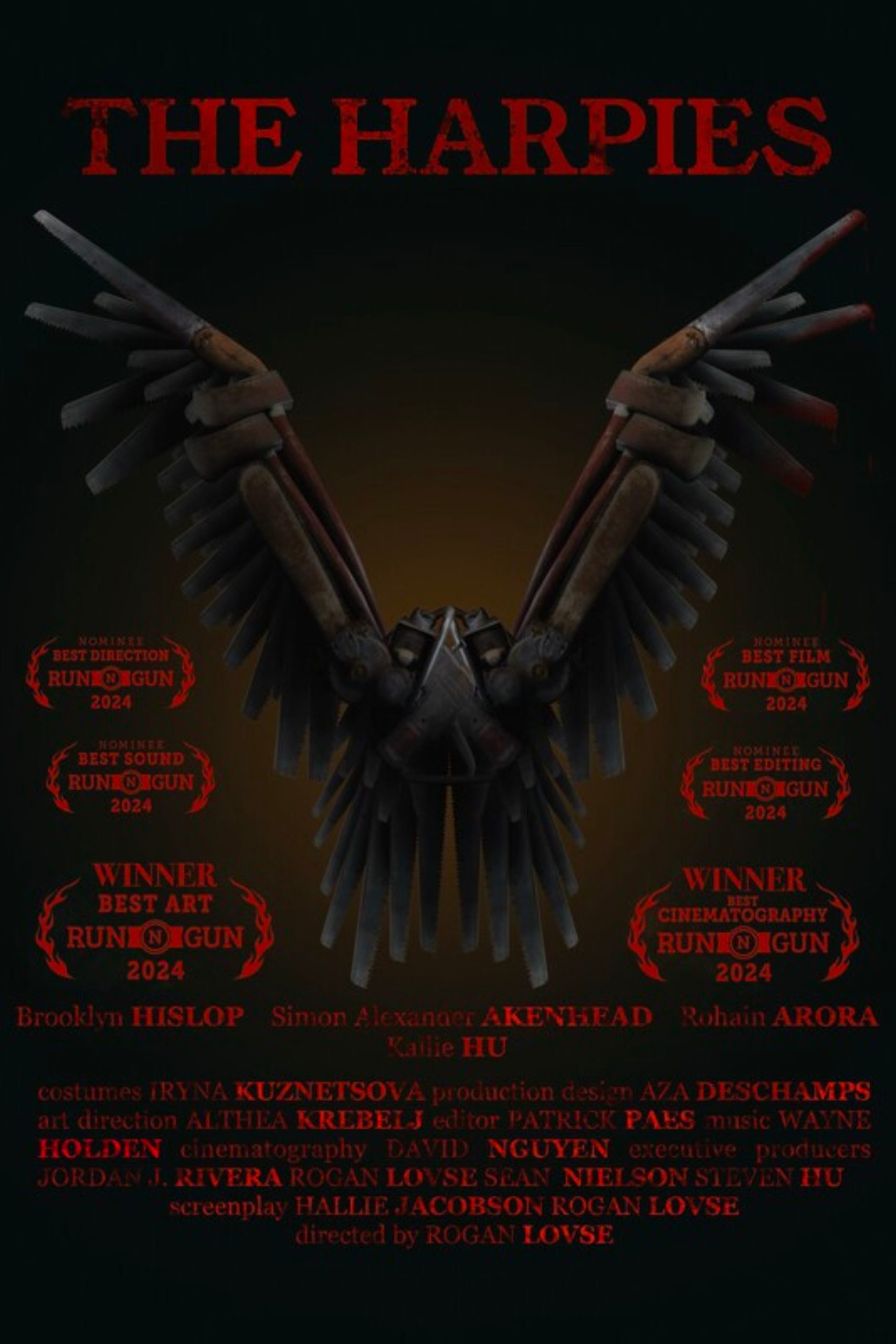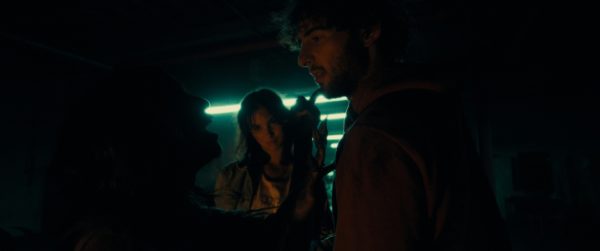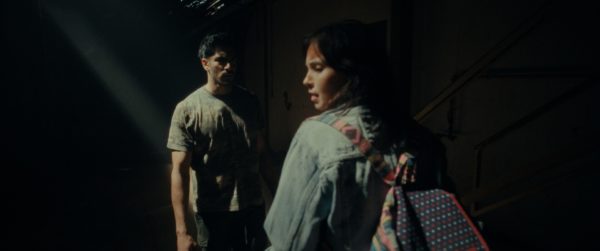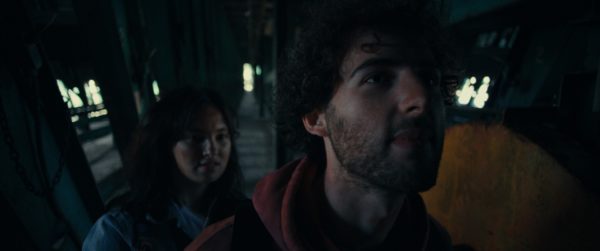Short Film
The Harpies
„The Harpies“ wurde im Rahmen des Run N Gun: Vancouver’s 48-Stunden-Filmwettbewerb 2024 in nur 48 Stunden geschrieben, gedreht und geschnitten. Der Film gewann die Preise für Beste Kamera und Bestes Szenenbild und war zudem nominiert für Bester Film, Bester Schnitt, Bester Ton und Beste Regie.
Aura ist auf der Flucht vor ihrem Ex-Freund. Begleitet wird sie von ihrem Freund Matt, der schon immer eine unangenehme Schwärmerei für sie hegte. Die beiden suchen Schutz in einer verlassenen Sägemühle – ohne zu ahnen, dass dort eine gefährliche Harpyie ihr Revier hat.
Auras Ex, Devin, stellt sie in der Mühle – doch dann lockt ihn das hypnotische Lied der Harpyie in die Dunkelheit, wo er kurz darauf grausam aufgeschlitzt wird. Aura handelt schnell und setzt Matt einen Gehörschutz auf, um ihn vor dem Gesang der Harpyie zu schützen. Dann trennen sich die beiden und fliehen in verschiedene Richtungen.
Während der Trennung entdeckt Aura eine mysteriöse Botschaft an der Wand, die andeutet, dass ihr jemand – oder etwas – helfen könnte. Doch die Harpyie greift sie an und verletzt sie am Arm. Aura verliert das Bewusstsein und erwacht später in der Höhle der Harpyie – verändert.
Matt taucht auf und bietet an, sie in Sicherheit zu bringen, während er weiterhin mit ihr flirtet. Genervt von seinen Avancen wehrt Aura ihn ab. Matt gerät in Rage und behauptet, sie schulde ihm etwas für seine „Hilfe“. Doch er bemerkt nicht, wie sich die Harpyie von hinten anschleicht. Aura entfernt seinen Gehörschutz – und die Harpyie verzaubert ihn mit ihrem Gesang. Gemeinsam töten Aura und die Harpyie Matt für seine Dreistigkeit… und machen sich über ihn her.
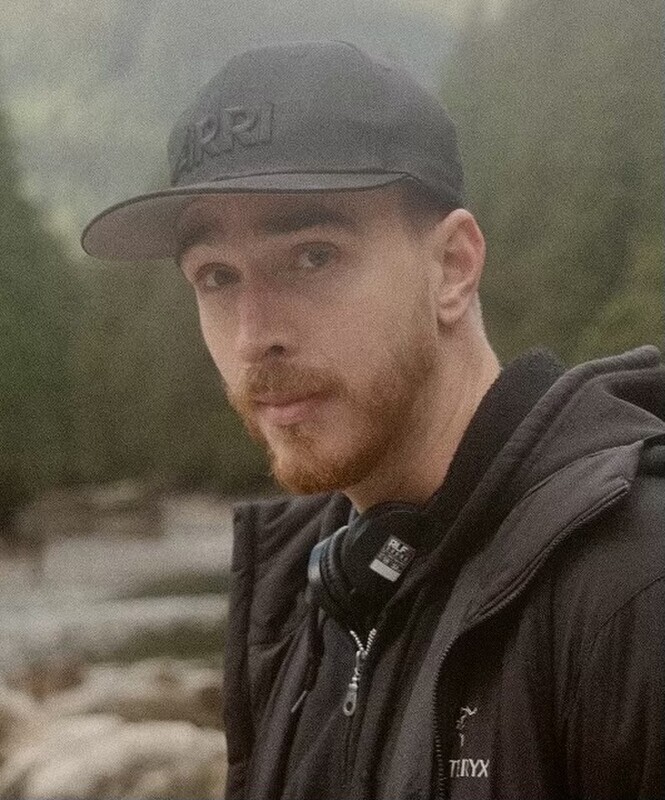
Rogan Lovse
Rogan Lovse is a first-time director and aspiring cinematographer based in Vancouver, BC with over 8 years of experience on a plethora of IATSE projects in both the lighting and camera departments. He has always fostered a love of storytelling and has wanted to write and direct for film for a long time.
Rogan has had the opportunity to learn from a multitude of established cinematographers that have helped to hone his craft. That combined with significant technical knowledge of camera systems, from working as a 1st AC, has led to a budding portfolio of projects as a cinematographer.
This year, Rogan was accepted into the ASC’s Vision Mentorship Program. Recently, he was awarded Best Cinematography at Vancouver’s 48 hour “Run N Gun” film competition. Believing in
the mantra that cinematography, and filmmaking in general, is about making informed and intentional choices to support a story with images, Rogan is always looking for a new project to exercise and expend his creative skillset. He has wanted to apply what he has learned for many years to direct a film and is ecstatic to continue to grow as a filmmaker and storyteller.
Director Statement
colour and complete post sound within 48 hours. Because of the nature of the competition, I had to tackle directing the project in a backwards manner. Not knowing what elements would have to be included in the script beforehand, we had to plan out everything we could without having access to a script. Normally I would use the script as the blueprint for style of shooting, casting, locations, etc. With this project we had to cast without knowing what our characters would be, plan out a couple rough shooting styles, and lock down location, crew, and equipment first. We set out to secure a highly cinematic location to provide more opportunities for interesting visual storytelling, cast a small group of actors that we had either worked with before or that had good charisma and chemistry with one-another, and chose lenses and a camera that would allow us versatility to try different aesthetics on the day. I decided we would try to stick to horror as a genre, regardless of the elements that we had to incorporate for the competition. This would give everyone in cast and crew at least some broad strokes to plan their approach to the film.
Once it was time to start writing with my writing partner, we mapped out how to incorporate the elements into a tight story very quickly. We wrote the script in only six hours and worked to incorporate the elements in a seamless way so they wouldn’t feel forced. The elements that had to be included were: a hat, alternate universe, a line written or spoken in another language, and the line “Ever since I met ______, nothing has been the same”.
When shooting horror I try to utilize anti-framing to create a sense of unease in the audience; creating the idea that something might be sneaking up on the protagonists. We also utilized voyeuristic shots to craft the feeling of being watched. We also wanted the lighting to feel natural and real to contrast the mythical creature in the film and make the threat feel more realistic. The psychology of the opening shot of the film was important to establish the journey our audience would be taking off the bat. The architecture of the space looks like a series of metal teeth surrounding the characters. This feels like they are stepping into the maw of a great beast and establishes a sense of danger right away. The film had to be four minutes and thirty seconds, as a maximum, and it was important to establish that we were doing horror right away. The one hundred eighty degree rotation of the shot helps to accentuate that something is wrong in the world we’re in and that drives home the horror element. I also wanted the film to get progressively darker as the characters traveled deeper into the sawmill and deeper into the narrative. This helped show a progression of horror throughout the film before the climax. Starting with daytime and a red herring villain of Aura’s ex boyfriend before transitioning to dark interiors with a mythical Harpy was an intentional storytelling tool.
The design of the creature was a mix of a traditional harpy and inspiration of Japanese style ghosts. The idea was to have a feminine creature that we could imagine was once beautiful before they were tarnished by the actions of the men in their life which led to them becoming a harpy. The Japanese ghost inspiration was truthfully just because their aesthetic is terrifying to me. Blending the two images works because we already know it’s a horrifying image. Budget was also a factor in the sense it’s easier to make that style of creature look scary on a budget and make it more about performance than trying to do an elaborate bird creature. The movement of the creature was inspired by the jerky snapping movements birds tend to make. It’s natural and yet unnatural at the same time. We also kept the creature in the dark as much as possible. Creatures tend to only be scary until you see them in all their glory. Our imagination will always scare us more than reality. Sound was a major storytelling tool in the film. Ultimately it’s a film about a mythical creature that kills with sound. Adding to that we didn’t have the budget to make gore look realistic and visceral; it made more sense to keep the creature in the dark and let sound fuel the audience’s imagination. When Devin is killed, it was always meant to happen completely offscreen in the dark and utilize blood curdling screams and the sound of snapping bones to build a nightmare. I wanted to use the zoom lens as well to show the perspective of craning to get a better look from a fixed point instead of dollying towards the action. The harpy’s song had to be beautiful and ethereal to lend to the idea of lost beauty and also the mythical aspect of the creature. We played with the idea that only the men could hear the harpy’s song. When the harpy was “singing” and the story or shot was being told from Aura’s perspective, we used bird sounds instead for what she would be hearing. Furthermore we performed a “vertigo” shot on the male actor’s whenever they would hear the harpy’s song to show the world melting around them as they became absorbed with the hypnotizing sound. Music as well was meant to unnerve our audience off the hop with creepy, otherworldly sounds before building tempo in the climax to raise the blood pressure of the audience in the final moments. Ultimately, even though the film was made in a 48 hour time period, every decision was made with intention based on telling a story about trauma and empowerment, while unnerving the audience with horror cinema psychology.
Cast & Crew
Director:
Rogan Lovse
(The Dandelion Girl)
Writers:
Hallie Ann Jacobson
Rogan Lovse (The Dandelion Girl)
Producers:
Jordan J. Rivera (High Heels, The Dandelion Girl)
Steven Hu (High Heels, The Dandelion Girl)
Sean Nielson
Key Cast
„Aura“ – Brooklyn Hislop
(DC’s Legends of Tomorrow, Once Upon a Time)
„Matt“ – Simon Alexander Akenhead
„Harpy“ – Kallie Hu
(DC’s Legends of Tomorrow, Grease: Rise of the Pink Ladies, Yellowjackets)
„Devin“ – Rohain Arora
(Allegiance, Avatar: The Last Airbender, Superman & Lois)
